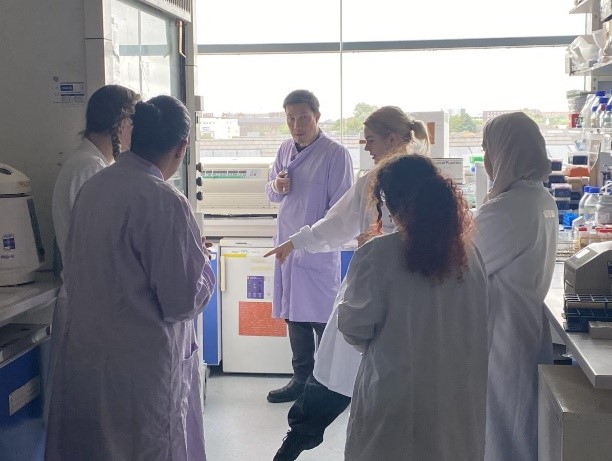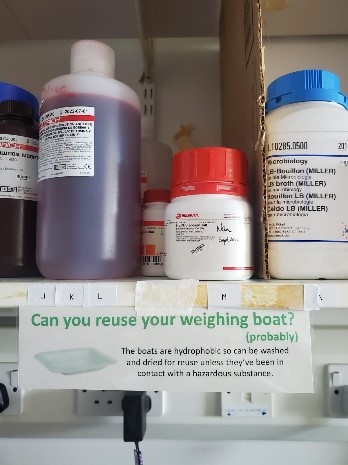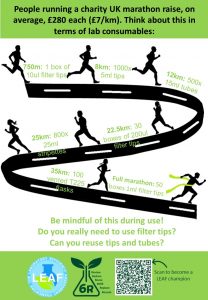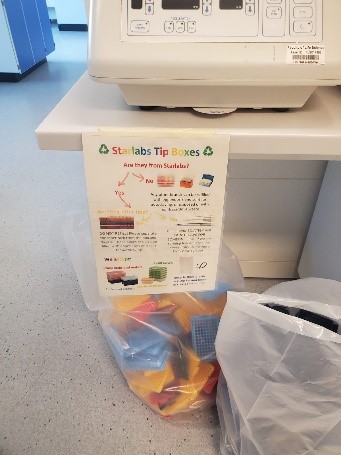
Top tips from Gold LEAF champions
Blog by Isobel Taylor-Hearn, FBMH PhD student, Gold LEAF champion and LEAF trainer and auditor. To find out more information about LEAF contact Eemaan. To find out more about the content of the blog, contact Bel.
In July 2023, we had the pleasure of hosting a group of UoM staff for a tour of our lab to showcase steps we’ve taken to improve sustainability and actions we have undertaken to achieve a LEAF (Laboratory Efficiency Assessment Framework) GOLD award. Sustainability in the scientific community is crucial for the wellbeing of our planet, and we were eager to share the positive impact that simple, yet impactful changes can have on our environment. Here are a few of the key practices we’ve adopted to promote sustainability and how they’ve made a significant difference in our lab operations.

1. Make People Mindful
One of the biggest challenges in promoting sustainability is overcoming ingrained wasteful practices and changing mindsets. In the lab, people often perform actions on autopilot without considering the environmental consequences, or they have not yet realised that we all need to improve sustainably at work as well as at home, and that the impact is likely to be greater at work if one works in a lab. To combat this, we introduced simple prompts and reminders to make lab members more mindful of their actions. Stickers and posters were placed around the lab to remind users to switch off equipment and close fume cupboard sashes when not in use. Additionally, we introduced posters to question common practices such as whether single-use tubes could be replaced with reusable glass bottles, if weighing boats could be reused, or whether single-use stripettes could be substituted with measuring cylinders.
Moreover, we implemented posters highlighting the financial cost of consumables, which are often funded by charities. By increasing awareness and mindfulness, we’ve seen a positive shift in the way our lab members carry out experiments, leading to reduced waste and resource consumption.


2. Empower People
We believe that individual actions, no matter how small they may seem, can collectively have a substantial impact. By educating our lab members about the environmental consequences of their actions, we have (hopefully!) empowered them to make greener decisions. For example, we shared the knowledge that leaving a fume cupboard open uses as much energy as two to three UK households. However, simply clearing the hood and closing the sash after use can cut energy consumption in half. If all labs in the department made this simple swap, we could save the equivalent energy of 170 UK homes every year!
Similarly, we encouraged switching from 1.5ml to 0.5ml tubes for experiments requiring small volumes, halving plastic use. Furthermore, switching from a single-use 25ml stripette to a measuring cylinder once a week could save nearly 1kg of plastic annually. Small changes like these may seem insignificant on an individual level, but when adopted collectively, can lead to substantial reductions in resource consumption and waste generation
 3. Make it Easy for People
3. Make it Easy for People
In our quest for sustainability, we recognised the importance of making green decisions as effortless as possible for people. We strategically placed recycling bins at multiple locations within the lab to encourage proper disposal of various items, including plastics, paper, stationery, batteries, glass and electricals. By providing accessible recycling options, and teaching lab members best practice for disposal, lab members don’t need to spend time searching for specialised bins or figuring out how to dispose of different materials properly.
4. Get Organised
Organisational efficiency plays a crucial role in reducing waste and optimising resource utilisation. We recognised that a lot of waste came from repeating experiments that had already been performed by others, or reordering reagents that we already had. To address this, we implemented a lab management system (Labcup) to take stock of our inventory, helping to avoid repeat orders. Expired TC consumables, in-date reagents and plasticware were all rehomed across the faculty, reducing waste and improving sustainability. Conducting regular lab clear-outs and cataloguing remaining stocks has allowed us to discard unwanted samples, freeing up valuable space in cold storage and aiding fast location of useful items.

5. Question Legacy Practices
Some of our green swaps came from questioning long-standing practices. For example, we used to autoclave all tips and tubes in the lab, assuming it was necessary. However, after trialling consumables without autoclaving we found that the autoclave procedure was not essential for most lab uses. By eliminating this step we managed to save a significant amount of energy and water. Furthermore, rinsing and reusing tips and tubes has been adopted for many experiments.
We are now looking into setting our ULT to -70°C rather than -80°C. ULT freezers used to be set at -65°C or – 70°C, but in the 1980s, manufacturers started to develop lower temperature freezers. Despite the increased energy cost, no evidence was provided that lower temperatures improved sample stability or recovery, and the scientific community did not challenge this. Increasing the freezer temperature by 10°C can reduce energy consumption by 30% while preserving sample integrity. Many laboratories around the world have switched to -70°C or -75°C (reduced energy consumption by 15%). Some did this a long time ago, sometimes keeping one freezer at -80°C for precious samples. This PPT by one of our LEAF champion presents some of the evidence – more publications per sample type are curated on our Sustainable lab team site – accessible by LEAF champions.
Before or concomitant to raising ULT temperature, one needs a good clear out, a robust organisation of samples, and a good maintenance of ULT. This can reduce energy consumption by 10% and clear precious space. It is also the most effective way to protect samples integrity by limiting temperature variations caused by longer than necessary door opening time, or the door not closing well due to excess ice or poor maintenance of the door seal (see PPT for details). 
6. Conclusion
Incorporating sustainability practices into our lab has been a journey of small but powerful changes. By making lab members mindful, empowering them to take action, simplifying green choices, getting organised and questioning outdated practices, we’ve made significant strides towards reducing our environmental impact. We hope that our experiences inspire others in the scientific community to implement similar sustainable practices and contribute to more sustainable science.
More lab tours will be organised for LEAF champions. Dates will be announced on our sustainable lab network Teams site.
Find out more about LEAF: LEAF (The University of Manchester).
For other queries:
Email: maggy.fostier@manchester.ac.uk for Environmental Sustainability and LEAF queries
Email: lydia.wunderley@manchester.ac.uk for recycling queries and please forward emails of new products or recycling schemes.
To find out more about Environmental Sustainability in FBMH: visit the Faculty’s intranet page, website or contact srbmh@manchester.ac.uk.You can also sign up to our Faculty ES Good Newsletter; please contact srbmh@manchester.ac.uk to join our mailing list. For more information on Environmental Sustainability at the University watch this short film or visit their website

0 Comments